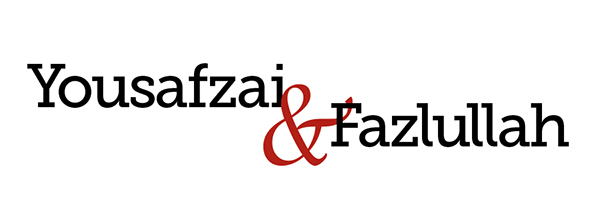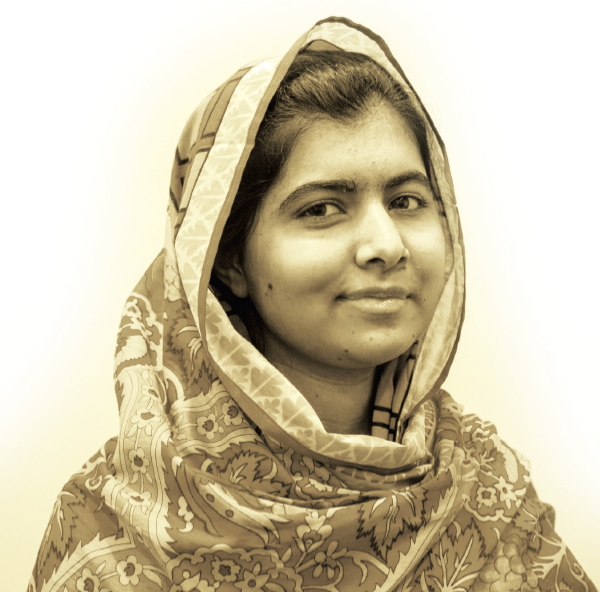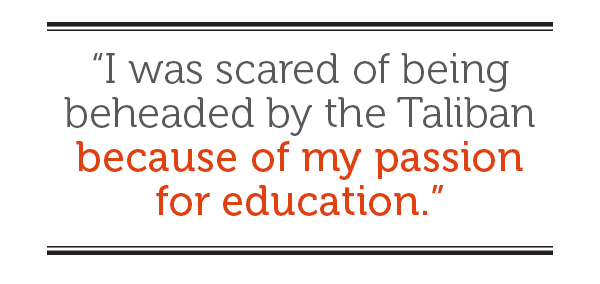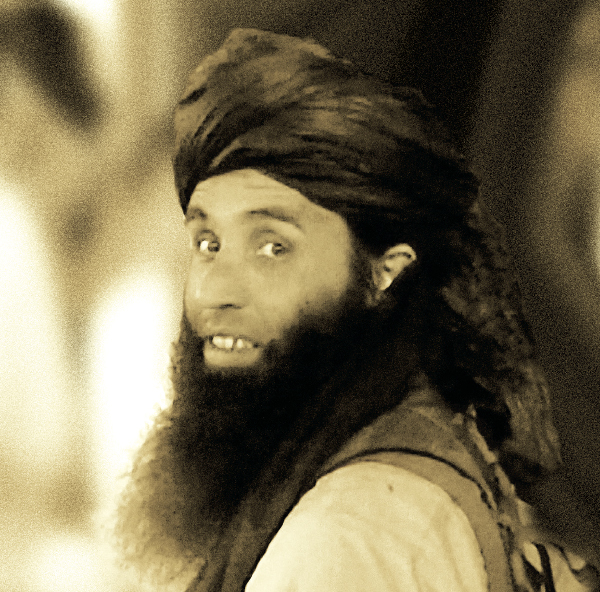
HERO: MALALA YOUSAFZAI

On Oct. 9, 2012, 15-year-old Malala Yousafzai was returning from school when a man jumped onto the van’s tailboard and shouted, “Who is Malala?” One of three bullets fired struck Yousafzai in the left side of the head, rendering her unconscious.
The shooting was the culmination of Yousafzai’s refusal to be silenced by Taliban oppression. Four years earlier, Yousafzai had given her first speech protesting forced school closures, entitled “How dare the Taliban take away my basic right to education?” It was a courageous but dangerous defiance of the Taliban, the Sunni Islamic political movement and military organization which had overrun Pakistan’s Swat Valley in July 2007.
Led by Mullah Fazlullah, 4,500 militants had captured key villages, killed local leaders and forced government officials to flee. Fazlullah imposed Sharia law, with public whippings and hangings for perceived crimes becoming routine. On Jan. 15, 2009, all girls’ schools were closed.
Yousafzai, meanwhile, had begun blogging for BBC Urdu under the pseudonym Gul Makai—a Pashto-language folktale heroine. Between Jan. 3 and March 4, she posted 35 entries describing life under the Taliban. In February, Yousafzai also appeared on a Pakistan television talk show and was central to a New York Times 13-minute documentary—Class Dismissed—about the school shutdown. During another short film—A Schoolgirl’s Odyssey—she pleaded with U.S. Special Envoy Richard Holbrooke to protect the right of Pakistani girls to education.

By the summer of 2009, as Yousafzai was becoming better known, the Pakistani army managed to drive the Taliban out of Swat Valley. With the situation somewhat stabilized, Yousafzai’s activism resulted in her receiving Pakistan’s first National Youth Peace Prize that December. “I was scared of being beheaded by the Taliban because of my passion for education,” she told reporters.
After a short hiatus during which her school reopened, the Taliban reasserted its power back into the valley during the summer of 2010. Yousafzai’s continued outspokenness led to a Taliban internet declaration in early 2012 that she “should be killed.” Fazlullah then personally ordered the Oct. 9 assassination attempt. Airlifted to England for surgery, Yousafzai survived. An international uproar pressured Pakistan to ratify a right-to-education bill and launch a $10-million education fund in her honour.
Many awards and honours followed, including a 2014 Nobel Peace Prize that made her the youngest Nobel laureate. Today she continues advocating through the Malala Fund for the right of girls to education. “If one man can destroy everything,” she asked, “why can’t one girl change it?”
VILLAIN: MULLAH FAZLULLAH

Born in 1974, Fazal Hayat was radicalized at Sufi Muhammad’s religious seminary. In the early 1990s, he married one of Muhammad’s daughters, joined his father-in-law’s Movement for the Enforcement of Islamic Law, and assumed the name Fazlullah. In 2001, Fazlullah joined thousandsof Pakistani and other militants in fighting American, Canadian and other NATO forces in Afghanistan. Late that year, Pakistani security agents arrested Muhammad—creating a leadership vacuum that Fazlullah filled.
Fazlullah emerged as a vicious Sharia hardliner. In 2004, he launched a pirate FM radio station that provided a pulpit. Listeners were urged to pray five times a day, polio vaccinations were scorned, and women voting in elections was condemned. “We have our tradition that bans women from taking part in elections and violators will be punished,” he announced.
Nicknamed Radio Mullah, Fazlullah’s influence grew steadily. In November 2005, his criticism of the “evil of television” led locals to burn thousands of sets. “Now we have no other options but to reorganize our movement and work for a society purged of all types of evils including music, dancing and drinking alcohol.” Perceived Sharia violators were targeted for assassination, often by beheading.
In July 2007, Fazlullah’s militants seized the Swat Valley. Armed brigades patrolled marketplaces, forcing women and girls to be kept at home. Executions became daily fare. Despite Fazlullah’s movement losing popularity, the populace was too terrorized to resist.
Incapable of defeating Fazlullah’s forces, the Pakistani government negotiated two peace agreements. The first, signed on May 21, 2008, released Taliban prisoners and implemented Sharia in exchange for Fazlullah not challenging state authority. Within a month, Fazlullah demanded withdrawal of all troops and attacked army and police forces. The government responded with a fumbled June offensive.

Undaunted, on Jan. 15, 2009, Fazlullah ordered all girls’ schools closed. Another peace agreement followed in February, which soon collapsed with a Pakistani army offensive following in May 2009. This time, many militant leaders were killed or captured. Fazlullah fled to Afghanistan, from where he continued overseeing attacks within Pakistan, particularly in the Swat Valley.
His extensive reach enabled the attempt on Malala Yousafzai’s life. Fazlullah was appointed leader of Tehrik-i-Taliban Pakistan in 2013. More powerful than ever, he directed a December 2014 attack on Peshawar’s Army Public School that resulted in 151 deaths, including 130 children. Fazlullah’s rampage ended abruptly when a U.S. drone strike killed him on June 13, 2018.
Advertisement













